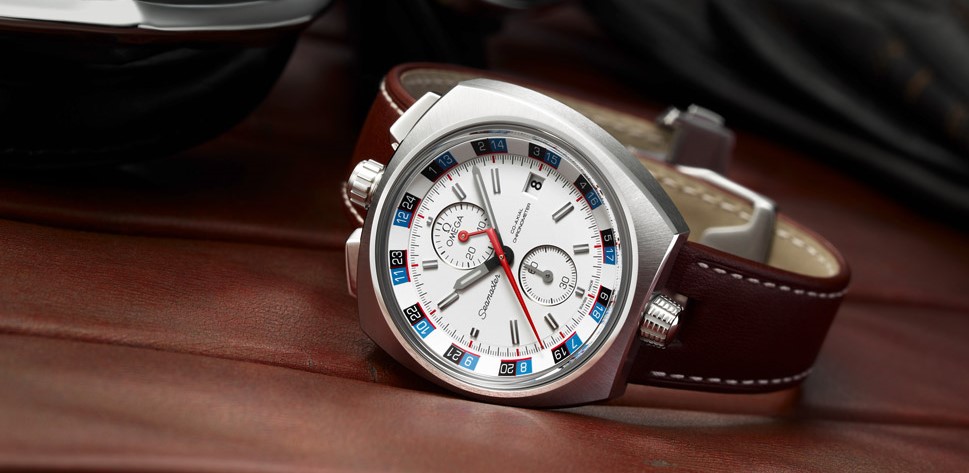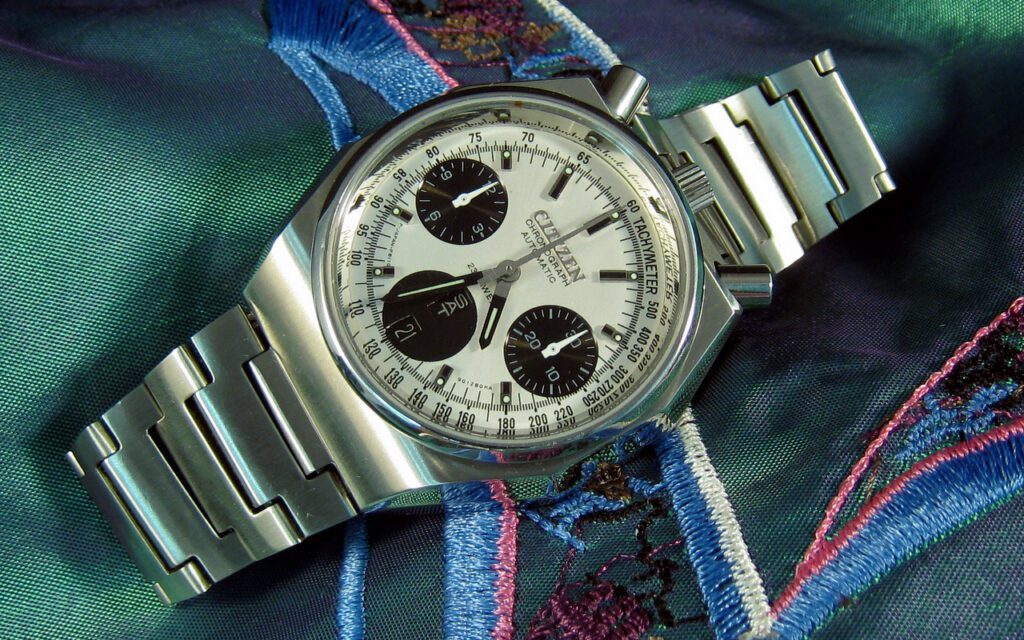Omega “Bullhead” Seamaster Chrono

1969 was a solid year for Omega. Their’ Speedmaster Professional was on Buzz Aldrin’s wrist during the first moonwalk; Their Electroquartz watch was first to production on the first-ever Swiss quartz movement—the Beta 21; And in that year they devolved their 27 CHRONO movement into the calibre 930. This updated hand-wound chronograph/date movement was featured on two big Seamaster releases—the De-Ville and the ever-unique “Bullhead” model. The prior of these two watches has a much more slim and traditional look, with its pressers and crown on the right side of the round case. Omega’s Bullhead, however, is a much more non-conventional piece that had plenty of contemporary flair upon its ‘69 release. Receiving its nickname from featuring the crown and pressers at 12-o-clock, its look has a no BS classic design.
The Look
Omega’s Seamaster Chronograph Bullhead is a superb retro snapshot. Tapering from top-to-bottom on the case design—in terms of case thickness—this watch sits higher on the wrist at the 12-position. At that same position, on the dial, there’s a Pepsi-colored subdial amidst an otherwise brown backdrop. That’s right—the watch dial features blue, red, brown, and black together. Though this color palette may be a bit tacky by today’s standards, it was par-for-the-course in men’s sportswear at the time. Speaking on being sporty—the hash-marks for the chronograph on this piece take on a checkered look. Generally, Bullhead style designs from this time kept racing stopwatches in mind. Omega was no exception in leaning into that aspect of the style—adding their own racetrack flavor to the stopwatch markings.
With an oblong four-angled case designed around an otherwise round dial, the Omega Bullhead almost looks like a piece of avant-garde architecture compared to more traditional shapes. This is an attractive aspect of the Bullhead style. Its shape breaks from traditional design—giving it a commanding presence (as long as you have a wrist that fits its size).
Holding things on the wrist, the band itself is shaped to accommodate the vertically-placed crowns and pressers. The six-o-clock crown, sitting polar opposite to the bull’s head, was designed to manipulate the interior bezel to dial-in greater chronograph accuracy. This crown gets its own slot cut out on the band—while the date/time manipulating top crown rests against the top half of the leather strap.
70s Style

Omega was certainly not alone in their Bullhead endeavors. Some companies with contemporary calibre 930 movement designs were Swiss watchmakers Lemania, Tissot, and Bucherer. Lemania made a non-date variant of the calibre 930, and Tissot made one with a composite material case. Bullhead mechanical watches were coming out of Japan at this time from brands like Citizen and Seiko, as well. More recently a model 8110A Citizen Bullhead was featured in the Quentin Tarantino film Once Upon A Time in Hollywood. This gold-plated Citizen automatic shines as a fitting retro style for a retro-centric piece of filmmaking.
A Rarer Movement
The only thing that really held back the 1969 Omega Bullhead, in terms of continued production, was the manual-wind aspect of its design. The calibre 930 movement was short-lived and thus lasted just one year in the Bullhead watch. As it stood, the movement was considered anachronistic even in the late 1960s. What made this original Bullhead leave production ended up building value in this style in later years—however. With such a limited release, this Omega Seamaster watch has become arguably the most collectible Bullhead from its time. Its near-exclusive build makes it worth a solid chunk of change. Even the 2013 re-issue of this piece sells online for thousands of dollars. Unlike the original 1969 release, though, the 2013 Bullhead runs on an automatic mechanical—instead of a manual-wind movement. Though multiple watch companies were using the Bullhead style for sports-style watch lines, Omega’s 1969 Bullhead remains supremely popular for retro watch fans. Bullhead watches themselves were often limited releases, giving them an allure all their own. So if you dig Omega’s Seamaster—or any other Bullhead style—check out third-party sellers and see if you can find a good deal. They can range from a few hundred to thousands of dollars, depending on personal taste and rarity.
Times Ticking has been in operation for more than 30 years, since 1982. We have performed watch repair for customers both locally and internationally. If it Ticks! We KNOW it! Our team of watch repair technicians have a combined experience in watchmaking of over 120 years.

